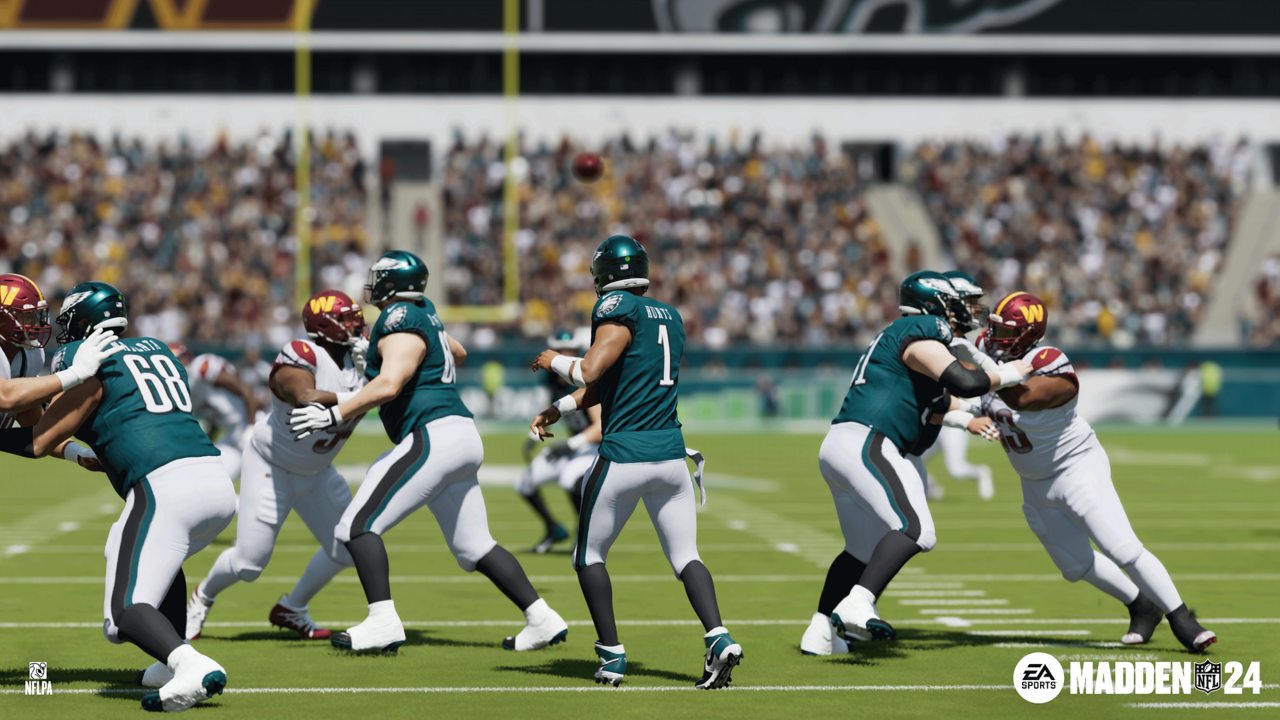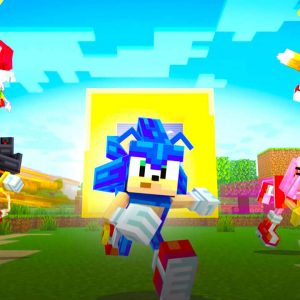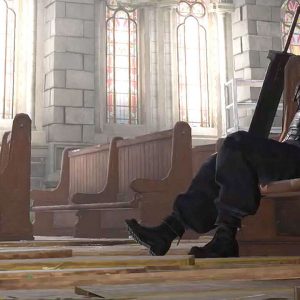As the biggest sport in the US, the spotlight on the few athletes talented enough to compete in the NFL can seem blinding, but it also burns out quickly for most players. The Tom Bradys of the world are rare, and the average NFL career might not even make it to the end of a player’s first contract. Where do they go from there? For former NFL offensive lineman Clint Oldenburg, life beyond football became football of a different sort. No, not soccer. Drafted by the Patriots in 2007, Oldenburg is today the production director of Madden NFL, and arguably the face of EA’s team that builds the annual and exclusive NFL sim. He was the first NFL player to make the jump into Madden game development, but since then, there’s been some emphasis within EA to bring in other NFL vets to help build the Madden games.
I recently got to chat with Oldenburg about moving from the field to the studio, the game’s…let’s say passionate fanbase, and the sage advice from history’s most intimidating mumbler, Bill Belichick, that still helps him in the studio at EA Tiburon all these years later.
“At the time that I came on, there was not [an emphasis on hiring ex-players],” Oldenburg told me. “However, in the meantime, since I’ve kind of grown through the company, that is something that I’ve actively owned and turned it into, let’s say here, some sort of pipeline.” The former lineman is now in his 12th year on the development team and explained to me how it all began.
“It was really kind of a mixture of opportunity, timing, luck–all that stuff came together. I knew I was reaching the end of my pro football career, I played about five years. Never got over that hump to get that second contract where you feel secure. And that business is really competitive. Every time that I was about to get over that hump–about two or three times in my career, I was pretty dang close–I’d have an injury that would kind of erase all the progress I’ve made that year. I had gotten released from Washington at the beginning of the 2011 season, and I wasn’t getting much more action from NFL teams, after I’d already gone through six teams and hadn’t stuck anywhere. So I knew I had to find something else to do.”
Without a locker room to call home, Oldenburg said it was around this time that he simply got lucky when browsing the internet for sports news. “I came across a job posting on the ESPN website. They were looking for former college athletes to come in as interns on EA’s college football game they had at the time. And I was a huge gamer. I loved Madden as my favorite game. As a kid I loved playing [EA’s NCAA] College Football. Interestingly enough, the person at EA who owned that internship, I didn’t know at the time, she became my wife and the mother of my kids. She was the recruiter of that program. So I met with her and ended up getting interviewed. Cam Weber interviewed me back then and I got hired as a design intern on College Football in January of 2012.”
Since then, six other former players have had a hand in developing Madden, either through contract work or, in the most recent case, a second full-time employee joining the team last year: former Cowboys defensive lineman Kenneth Boatwright.
To his excitement when he joined the Madden team, Oldenburg would be given the reins on improving the series’ blocking system–something he seemed uniquely equipped to handle. “Because I didn’t know how to make a game at the time, I started on the field. So what’s the first thing we learned in pass protection [in the NFL]? Stance and start, let’s start there,” Oldenburg told his new coworkers. “Let’s figure out what stances we want to use in pass protection. Let’s figure out what those first couple steps look like and capture that. We moved on to the brain, the logic, ‘Who are we going to target? And how are we going to put that into code?’ And it was just a long process. And that was the first thing and still the thing that I’m most proud of because that pass blocking system is still being used in the game [today].”
When he first arrived, Oldenburg said what surprised him the most was how difficult it is to make video game at all. “I think in our heads, subconsciously as gamers, we feel like, ‘Well, they just have some knobs to turn to do this thing. It shouldn’t take that long at all.’ I came in here not knowing how to make a video game, learning everything with on-the-fly job training. And I figured out very quickly that nothing is easy and there’s a lot of time and effort, blood, sweat, and tears that goes into making one of these things.”

Perhaps partly informed by Oldenburg and other ex-players’ involvement, the Madden team at EA Tiburon has been preaching authenticity more over the last few years, using it as the team’s guiding light when trying to design and implement new systems. That’s as strong a North Star as any, as sports fans usually want their video game sims to look, sound, and feel like the product they watch on ESPN, CBS, or Fox. But some elements of the game necessarily don’t lend themselves to this authenticity. They simply have to be more gamified. I asked Oldenburg how the team spots and reconciles these areas.
“You’re gonna take opportunities to gamify certain parts of the game or take creative license. One example [is] our Competitive game style. There are no injuries in Competitive because Competitive players don’t want some random chance that one of their best players on the roster might be taken out of the game that could impact the outcome of the game, right? So instead of injuries, the quarterbacks have a higher fumble chance in a Competitive game when they get hit when they’re scrambling. And that’s a way that we balance out. Otherwise there’s nothing stopping you from just running around with Lamar Jackson all day,” he said, surely eliciting bad memories from some Madden players reading this right now.
Oldenburg laughed when he admitted that he’s much more popular with NFL players in his current role than he ever was when he was wearing shoulder pads, saying he still hears from players inquiring about the game. “Usually it’s about ratings. They want their ratings ‘fixed,’ or they want certain things in the game, certain features changed. And then more often than not, it’s guys wondering how to get a job here. I get that actually more than anything: ‘When I’m done playing,’ or ‘I think I might be done playing. I want to follow your path. How do I do that?’ I talked to a lot of guys about that.”
Like many annual sports sims, Madden is both wildly popular and breathlessly criticized. Whereas spectators of Oldenburg’s old stomping grounds would be labeled Armchair Quarterbacks, video game development in an age of social media brings out enough hot takes to expedite global warming. I asked Oldenburg about how he handles the scrutiny from the game’s playerbase when they think he and his team have gotten something wrong.
“I think I’ve matured a lot. In my younger days, if you’d asked me that question three or four years ago, I would have had a long list of things that players got wrong, and that I wanted to explain to them. As I’ve matured, though, it doesn’t really matter anymore. If there’s something in the game that is causing a player to feel friction, then that’s a problem that we need to solve no matter if they have it right or wrong. Either we’re not explaining it correctly, it’s not coming across the right way, or maybe in some cases, we do have it wrong. Or maybe we over-gamified it, more often than not. I want to look at it through that lens.”
Having said that, Oldenburg did still–perhaps half-jokingly–admit fan feedback can be ruthless. What’s the tougher environment, I asked, an NFL road game or his Twitter mentions? “That’s a good question. I think with my perspective right now, it’s Twitter. The amount of eyes and scrutiny and all that stuff that’s on this video game, mentally, I think, mentally, this is harder.”

As it turns out, it was Oldenburg’s first NFL head coach and man of few words, Bill Belichick, who would help him deal with public scrutiny for years to come. His recollection would not only color in his time as a game developer, but offers rare insight into “the Patriot Way,” as football fans have called it for 20 years.
“[Belichick] took us [rookies] through pretty rigorous discussions about how to deal with the media. It was a very big initiative of his. He walked us through in his own unique style,” Oldenburg said. “‘You may be saying something to the media that has all good intent and you’re trying to be right and they can always spin it,'” Belichick would tell his players. So what was Belichick’s succinct recommendation? “‘Just shut the f*** up,'” said Oldenburg, quoting his former coach.
“He was like, ‘You basically need to give the most generic vanilla answers to every question they ask you so that you give nothing up. You throw no teammates under the bus, you give no bulletin board material.’ He basically trained us all how to be as boring as possible so that we would stay out of the headlines.”
As Oldenburg hopes to channel Belichick’s wisdom and stay out of the headlines–excluding this one, of course–in his post-football career, Madden NFL 24 will be making plenty of headlines like it does every August. Look for it to launch on August 18 for Xbox, PlayStation,and PC. If you haven’t yet, you can still preorder Madden NFL 24 and play it three days early.
The products discussed here were independently chosen by our editors.
GameSpot may get a share of the revenue if you buy anything featured on our site.
























